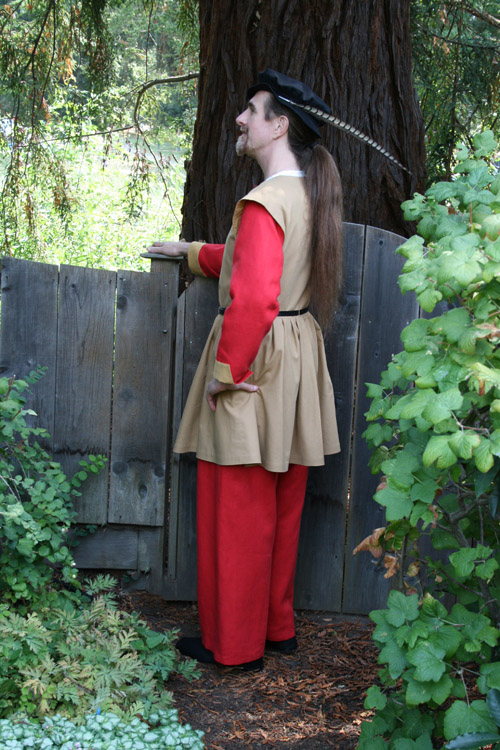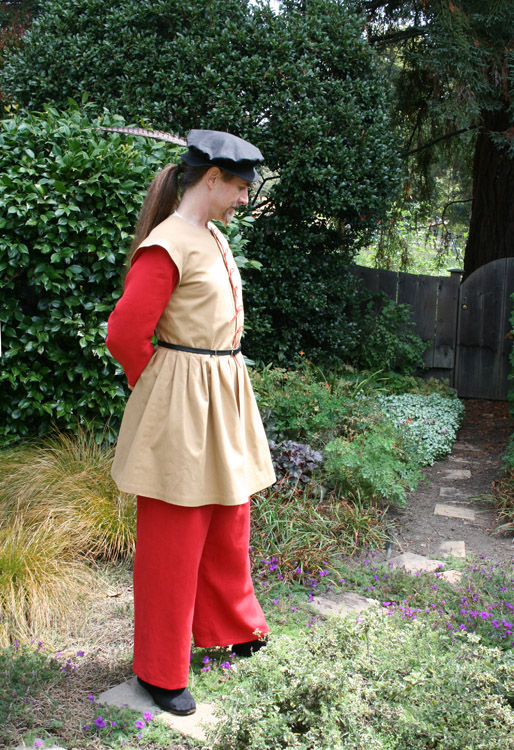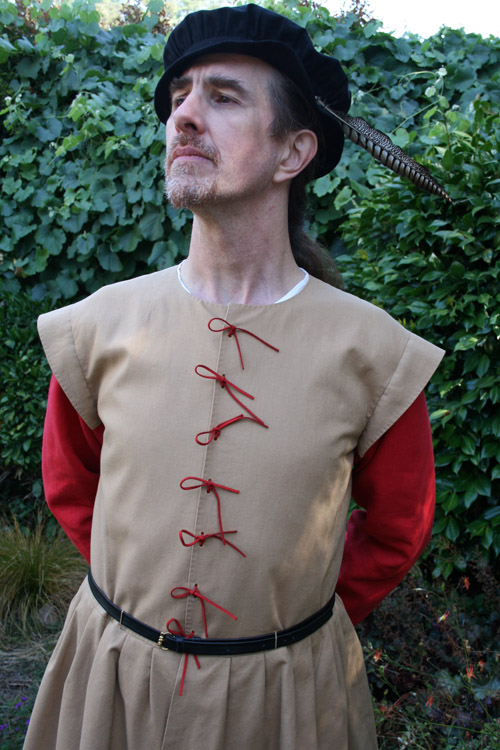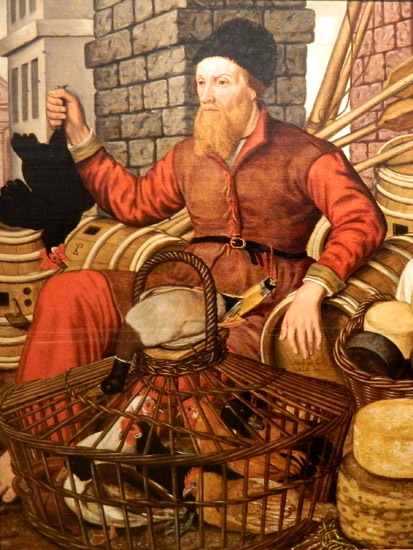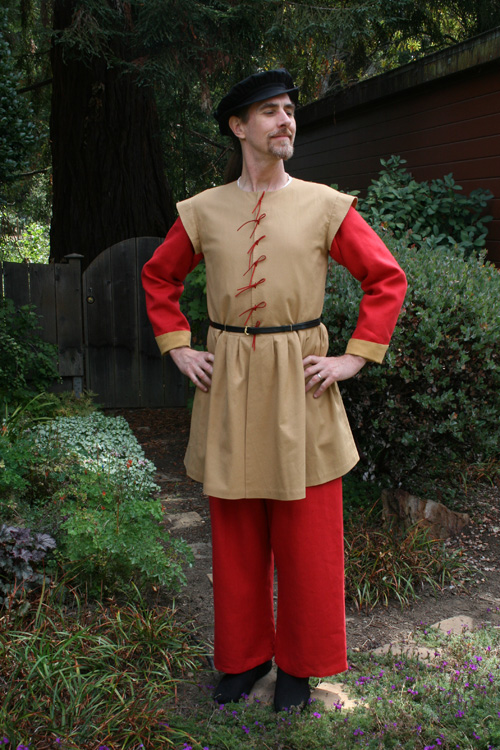
May 2016- June 2017
A Flemish peasant’s outfit inspired by the gentleman in Jan van Horst’s Market Scene. Designed to coordinate with my own flemish dress, it’s made from similar linens, cottons and blends. The ensemble is fairly straight forward. It’s comprised of a medieval shirt, skirted jerkin, separate sleeves, pants, and hat. Clicking on Market Scene below will take you to collection of images referenced for this project.
Kaufman essex linen blends are my go-tos for cool-weather, tailored garments. As such, I’m starting to run out of colors that haven’t already been used. The jerkin is made up in a fabric appropriately called “leather.” For the pants, I wanted a fabric that behaved like wool. The linen-cotton blend doesn’t fit the bill as it doesn’t drape. Though I was hesitant to pick wrinkly 100% linen, in the end the linen won out. There aren’t a lot of other good choices. “Firecracker red” 5.3oz linen, from Fabric-store was selected. The jerkin is also lined in a matching cotton chambray. The sleeve cuffs are faced with the same cotton. Pants and sleeves both have full linings of cotton bastiste.
Images that show Flemish pant details are few and far between. But I decided that they should be patterened with no side seam, and no buttonhole stand. I assume the crotch curves resemble breeches from the era. A modern pajama pant, Butterick 6837, was my starting point. Changes included lengthening the rise, removing the fly, adding width to the waist, and making the CF and CB less curvy. The pants were then pleated to a waistband in the manner of 17thC breeches in Cut of Men’s Clothes. They had to be hemmed twice as the annoying linen kept dropping while hanging. Close to ankle length is what you tend to see in the artwork.
In order to hold up the pants, I considered adding a few suspender buttons. But Aaron encouraged me otherwise. He finds a period lacing method much more comfortable. The lacing allows for an even distribution of weight. His shoulders don’t take the same kind of stress that they do when pants are held by braces. So pairs of fashion eyelets were run along the pants waistband. A length of pre-eyeleted cotton twill tape was sewn into the waist of the jerkin. And the pants lace into the jerkin. This combo worked out really well. The bonus being, I didn’t have to handsew a bunch of hidden eyelets.
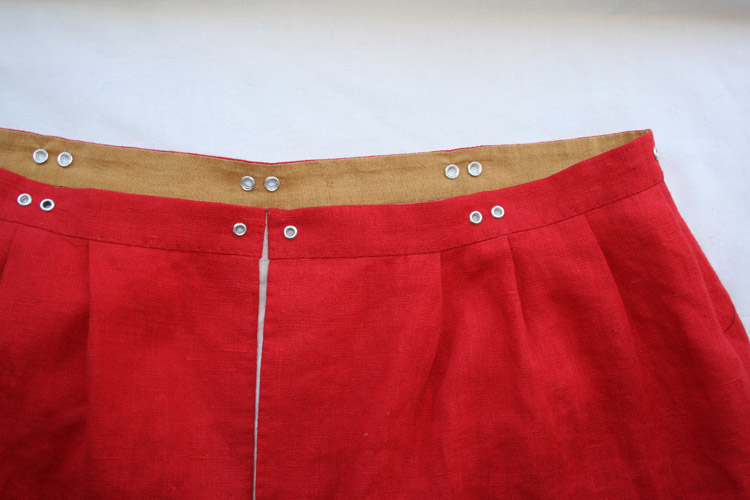

The long-skirted, sleeveless jerkin took less time to pattern. I used Aaron’s mid-16thC doublet block, which has a curved center front. The Tudor Tailor‘s jerkin skirt, p. 61, and Henrician sleeve, p.89 were also adapted. With a simple muslin underlining, the jerkin is comfortably lightweight. The skirt and wings are both finished separately, then whipped to the finished jerkin. Pairs of handsewn eyelets were added down either side of center front in DMC embroidery floss. Since this was the first time I’d made handsewn eyelets, it took me a few weeks to work out a method I could tolerate. The jerkin closes with 1/8″ sueded cords.
The sleeves have wrist openings which allow the cuffs to be rolled back, revealing a facing. There are no wrist closures. Along the top of the sleeve are more pairs of handsewn eyelets. The sleeves lace to ties sewn under the wings.
This belt was originally purchased for a different costume and never used. A nice soft leather, with a reproduction buckle, I hadn’t expected to use it for a peasant outfit. But it works. A few thread loops hold the belt in place. Two are sewn to the jerkin at side-front, as shown in 17th-Century Men’s Dress Patterns. One more is added to center back. Lastly, the hat is a simple Tudor Tailor bonnet in linen-cotton blend with a pheasant feather.
